Saint-Étienne are the second-most successful side, domestically, in French football history, with 10 top-flight titles to their name — a record that was only recently beaten by Paris Saint-Germain.
At the same time as PSG eclipsed Saint-Étienne to become the undisputed top dogs of French football, Les Verts made history of their own, though it was history of the unwanted kind as they suffered relegation from Ligue 1 for the first time in almost two decades.
ASSE are now in their second straight Ligue 2 season, and their second-tier stint didn’t look like ending this term by the midway stage of the campaign when they found themselves eighth at the time of ex-manager Laurent Batlles’ December departure.
However, his successor, Olivier Dall’Oglio — coming off the back of a year-plus absence from the sidelines following his Montpellier tenure and praised time in charge of Brest and Dijon, respectively, in the years preceding that — has successfully breathed life into Les Verts’ season.
At the time of writing, having just beaten Concarneau 1-0 at home this past weekend, they sit second and look to be hitting peak form at just the right time to push league leaders Auxerre heavily all the way to the finish line.
This Olivier Dall’Oglio tactical analysis piece will focus on how Dall’Oglio has significantly improved Les Verts’ defence in his 14 games as manager to engineer their sharp rise up the table, putting them right in the fight for promotion.
Data analysis
After an unsuccessful early-season experiment with a back-three, Batlles switched to a 4-1-4-1 five games into the 2023/24 campaign — the same shape that Dall’Oglio has used throughout his time in the Saint-Étienne dugout.
However, Les Verts were conceding 1.08 goals per league game during that four-at-the-back period under Batlles, essentially leading to plenty of points dropped.
Since Dall’Oglio’s arrival, ASSE have been conceding just 0.38 goals per league game — a stark contrast to their record under the previous head coach and a key reason why they’ve risen up the table during the Dall’Oglio tenure.
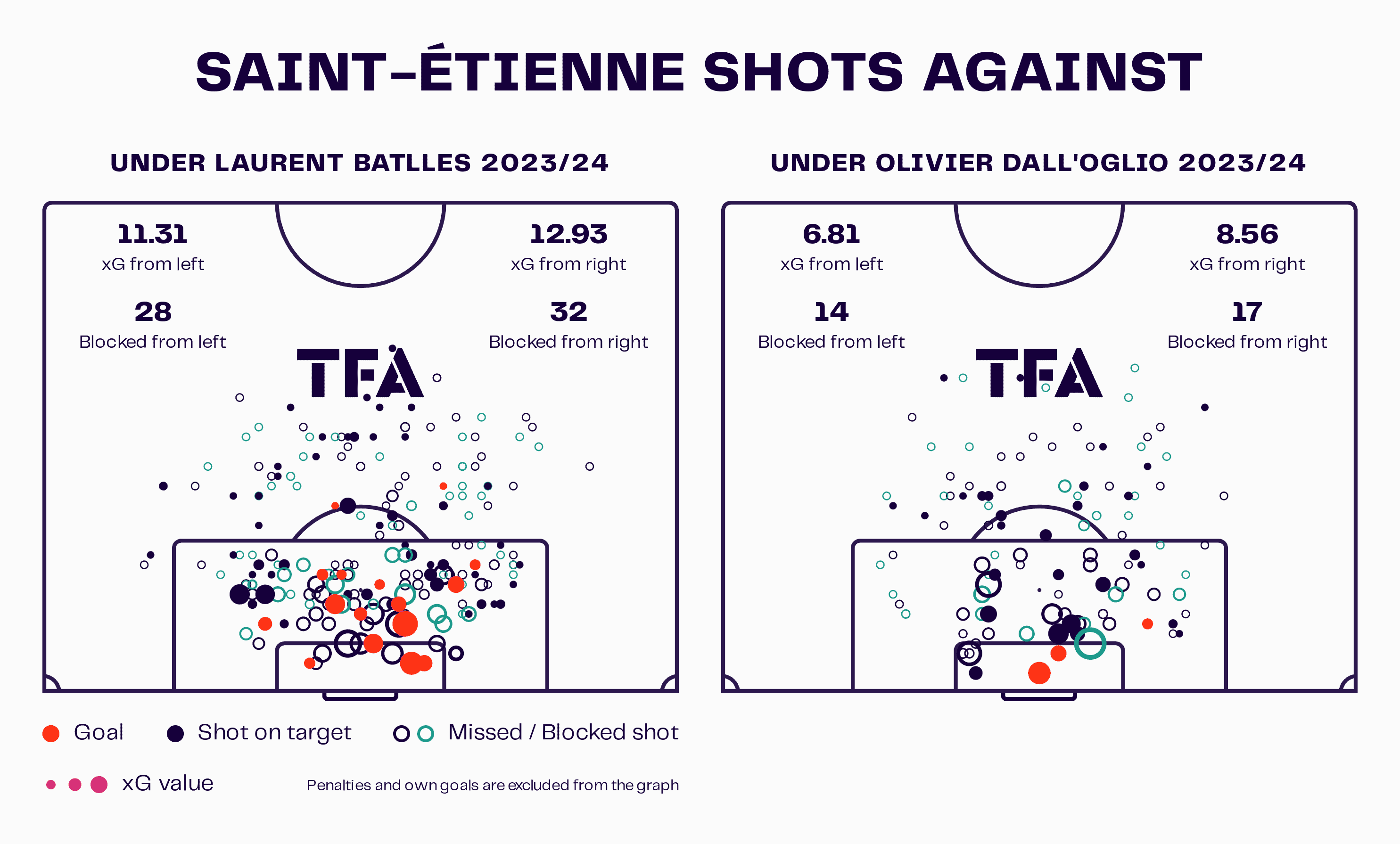
Saint-Étienne have been far better able to control their opponents and prevent them from threatening their goal under Dall’Oglio, leading to a far healthier shots against map as seen in figure 1.
Les Verts have conceded just 8.54 shots per 90 under their new boss thus far, compared with 11.5 per 90 earlier in the season.
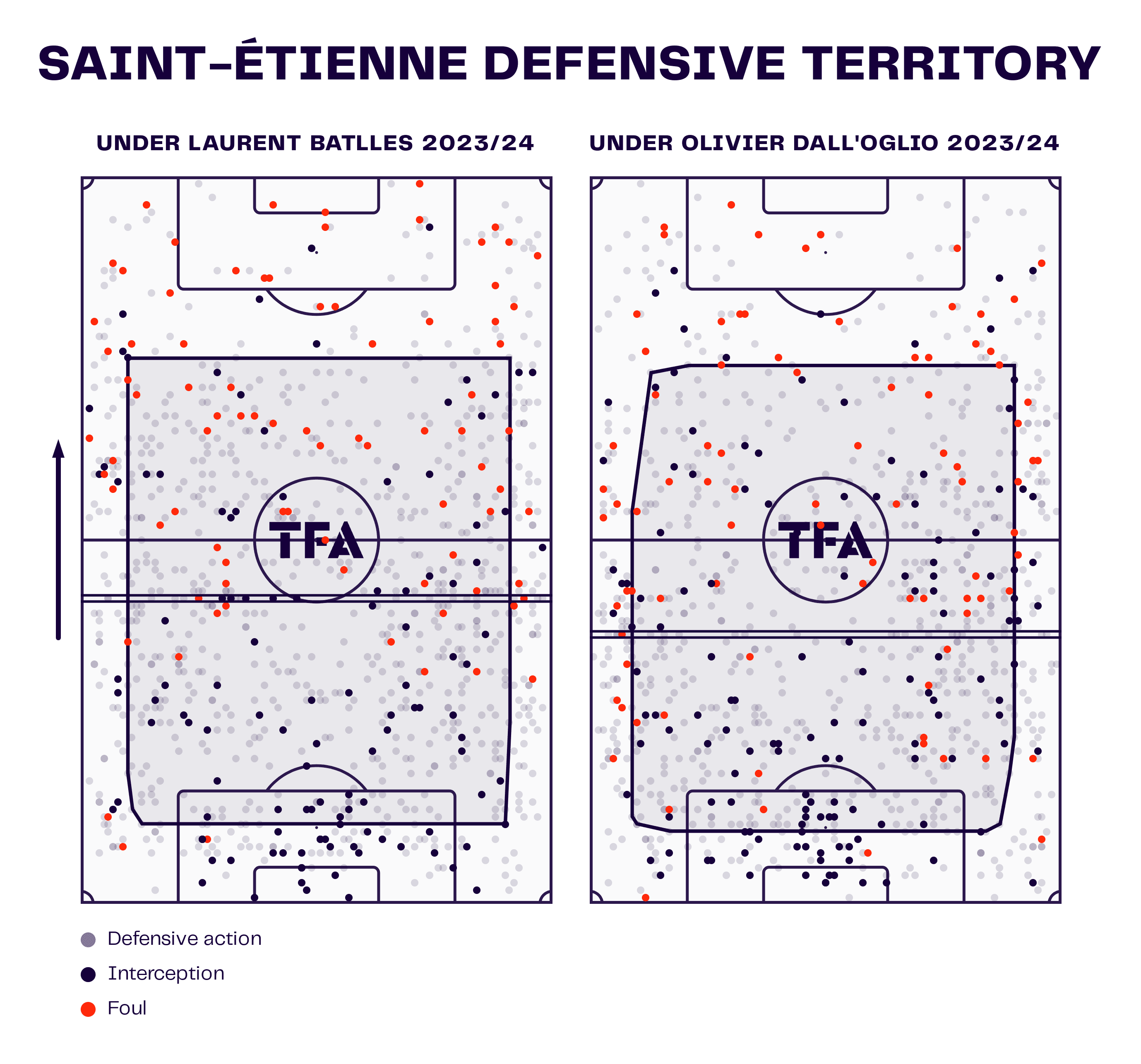
Furthermore, while their PPDA has dropped from 12.47 during the 12-game four-at-the-back portion of Batlles’ tenure this term to 9.20 under Dall’Oglio thus far, it’s worth noting that Saint-Étienne’s overall defensive actions have been occurring a bit deeper, with their defensive line also sitting a significant extent deeper as highlighted in figure 2.
This is typical of how Dall’Oglio has set up his teams defensively throughout his career, as will be examined in the next section of our analysis.
How Saint-Étienne press under Olivier Dall’Oglio
We published an analysis of Olivier Dall’Oglio’s Brest side back in 2021, which delved into his out-of-possession tendencies, including how he didn’t oversee an extremely high-pressing outfit but did take charge of a well-organised and efficient side in defensive phases. Those tendencies and many of the tactical nuances examined in that analysis are also present in Dall’Oglio’s Saint-Étienne thus far.
For starters, we examined how Dall’Oglio loved his Brest side to cut the pitch in half, with a striker, ‘10’ and/or holding midfielder playing a vital role in this with regard to their positioning in the middle of the pitch, between potential passing options so that the opposition would be pinned to one side, giving a smaller area of the pitch to play with and thus making it easier for the out-of-possession side to press aggressively and regain possession. This has been a vital aspect of Dall’Oglio’s Saint-Étienne and their successful out-of-possession tactics.
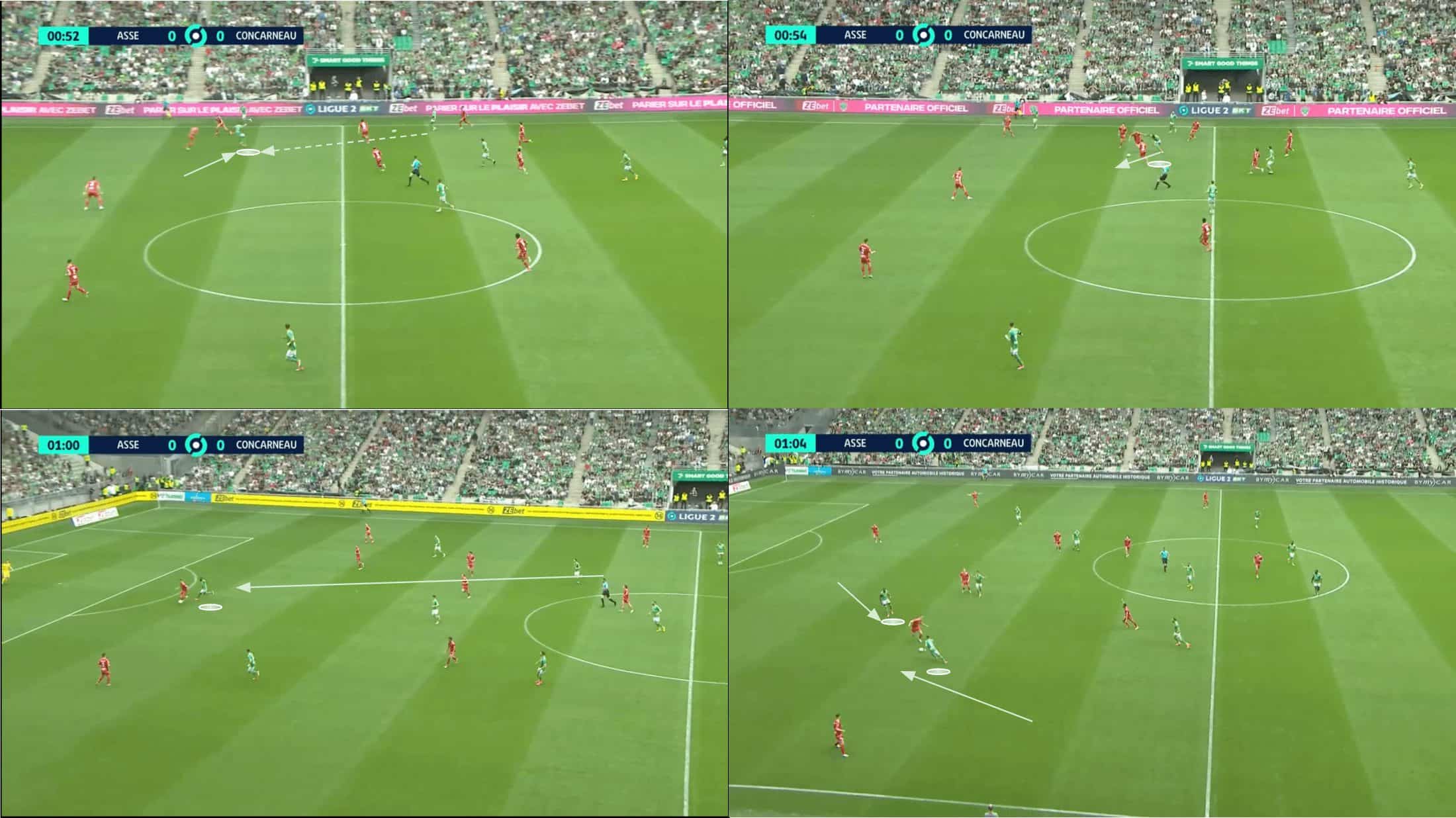
Take figure 3, for instance, where we initially find ASSE centre-forward Ibrahim Sissoko dropping to receive to feet only to be dispossessed as the opposition get in between him and the ball as he attempts to turn in the top-right image.
This isn’t the end of Sissoko’s job; in fact, it’s the beginning of a job just as important as his role in dropping off to support the ball progression — his defensive role in pressing the centre-back while keeping the opposite centre-back and passing options on the other side of the pitch in his cover shadow, thus pinning the opposition to the right-hand side of the pitch.
Sissoko maintains his pressure on this player while his teammates also mark nearby passing options on that right side tight. This forces the centre-back to hold onto possession of the ball for longer than he’d ideally want, leading to a turnover on the edge of the final third as the under-pressure ball-carrying centre-back is closed down by winger Mathieu Cafaro, who can now lead the ASSE counterattack.
This passage of play provides a perfect example of how Dall’Oglio wants his centre-forward to act in terms of cutting off the pitch when pressing the opposition centre-backs. He also wants the other players just behind that centre-forward to support him by marking nearby passing options tight, cutting them off, and thus piling the pressure on that ball carrier who has nowhere reliable to go.
This leads to the pressing trap shown here and discussed in our previous analysis of Dall’Oglio’s Brest between the forward, winger/full-back and near central midfielder.
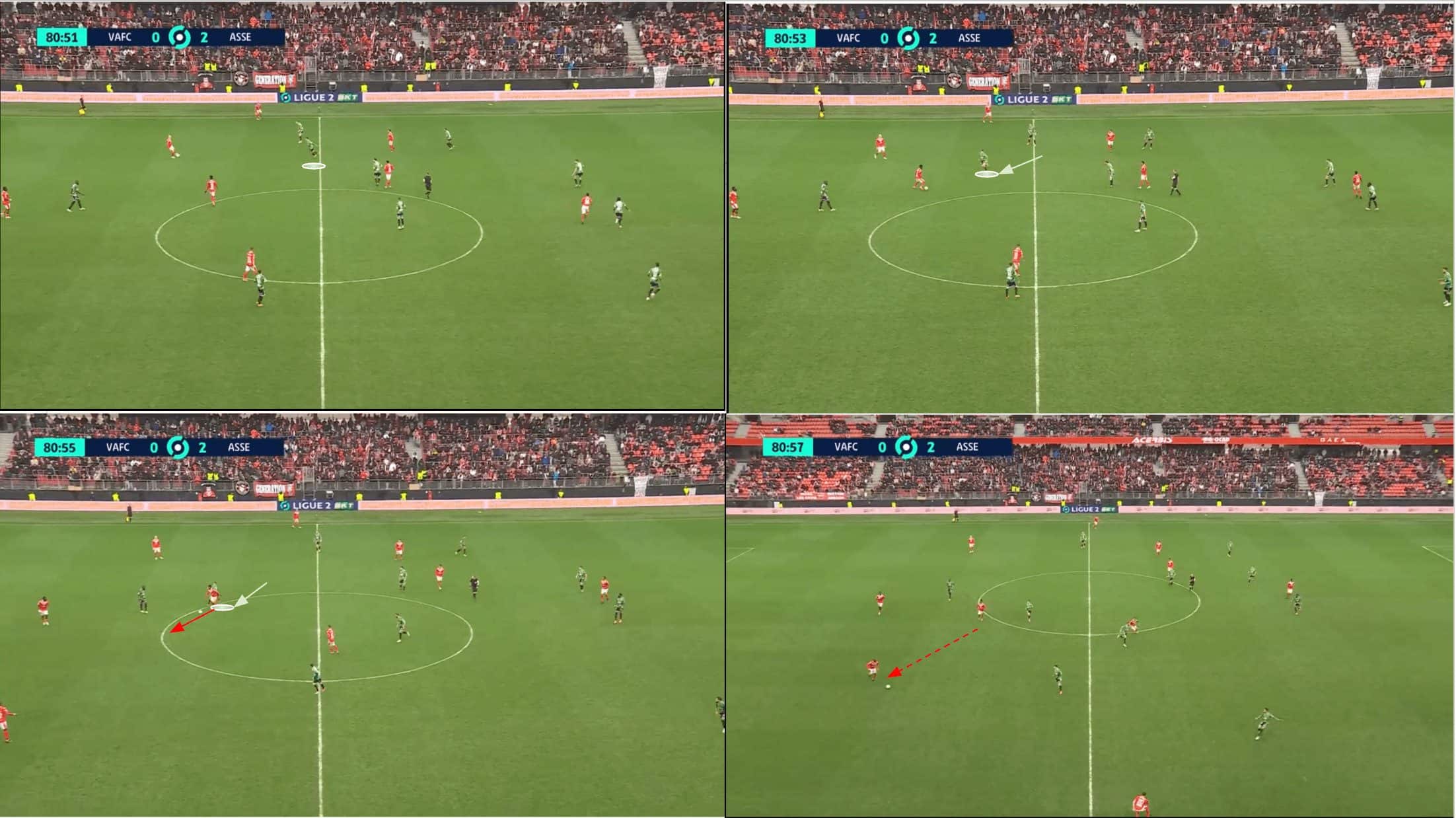
In this example, we find Saint-Étienne in the mid-block phase while their opponents try to progress into ASSE’s half. The left centre-back’s path forward is restricted by good positioning and spacing from Saint-Étienne’s players, including the right central midfielder, Dylan Chambost, who we find positioned well to block the passing lane between the centre-back and the attacker in the left half-space.
As the ball is played to the holding midfielder, Chambost adjusts his positioning to keep shadowing that player in the half-space while closing down the new ball carrier.
This effective pressing from Chambost, in combination with the tight marking from the rest of the midfield, prevents the midfielder from being able to play it forward, leading to the ball moving backward to the right centre-back.
From here, again, Saint-Étienne look to cut the pitch in half and keep all nearby passing options tightly controlled, meaning the ball carrier is delayed and Les Verts can mount pressure in this position.
It’s very common to find ASSE’s opponents stuck while Dall’Oglio’s side defend in a mid-block, as was the case in this example above. From here, it’s very common to find ASSE’s winning the ball back in the middle third out wide or in the half-space via the aforementioned pressing trap.
At Brest, Dall’Oglio relied heavily on a defensively active ‘10’ in the mid-block phase and at Saint-Étienne, though he primarily plays as a right-sided ‘8’ in possession, Chambost frequently performs that role in defensive phases, as we saw above.
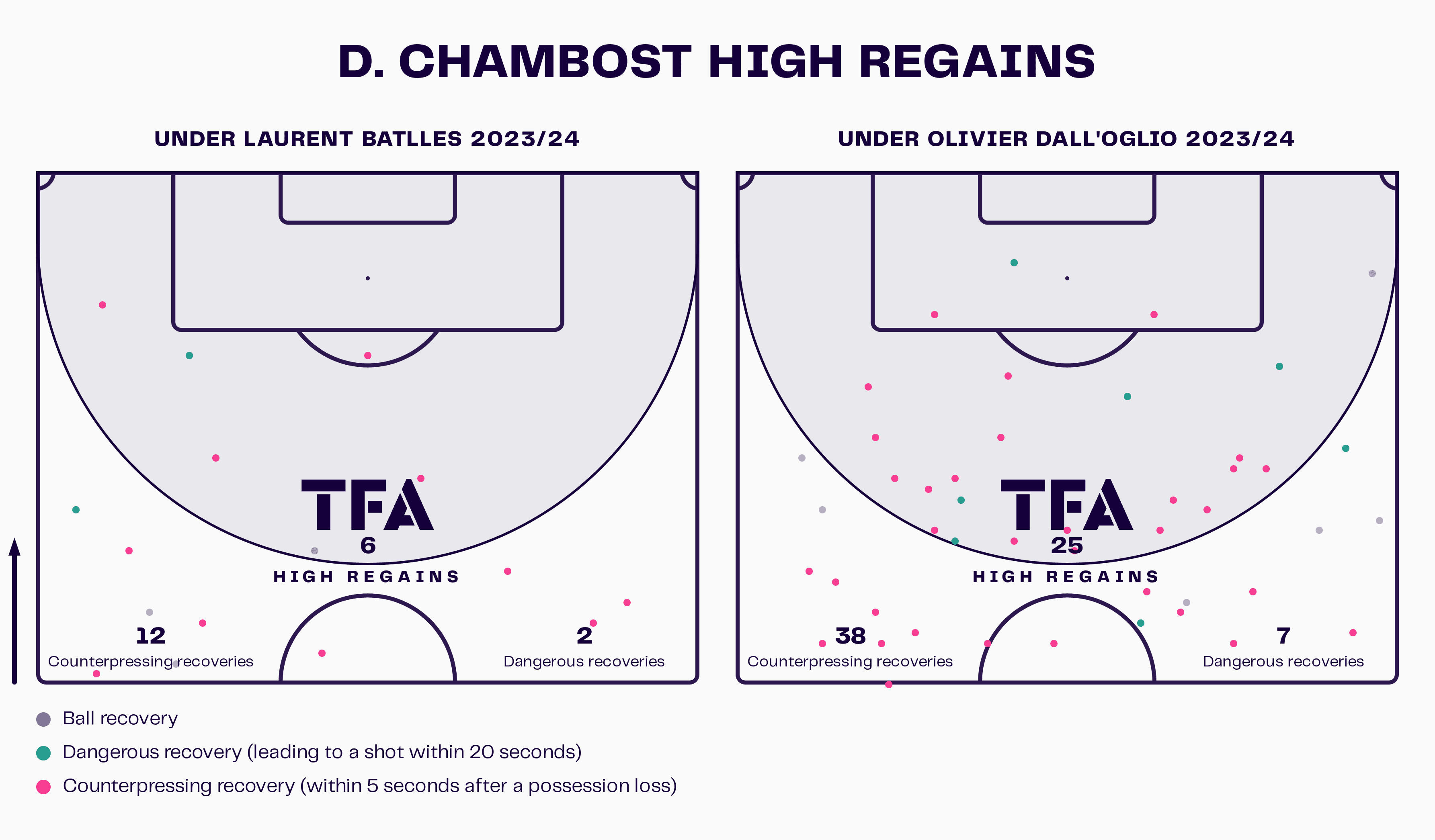
Chambost’s game time has increased significantly under Dall’Oglio compared to Batlles, who generally favoured Benjamin Bouchouari over him in the right-sided central midfield position due to his suitability for the out-of-possession role Dall’Oglio likes him to play as mentioned above.
This has naturally seen him make a lot more high regains in the second part of this campaign than he did in the first.
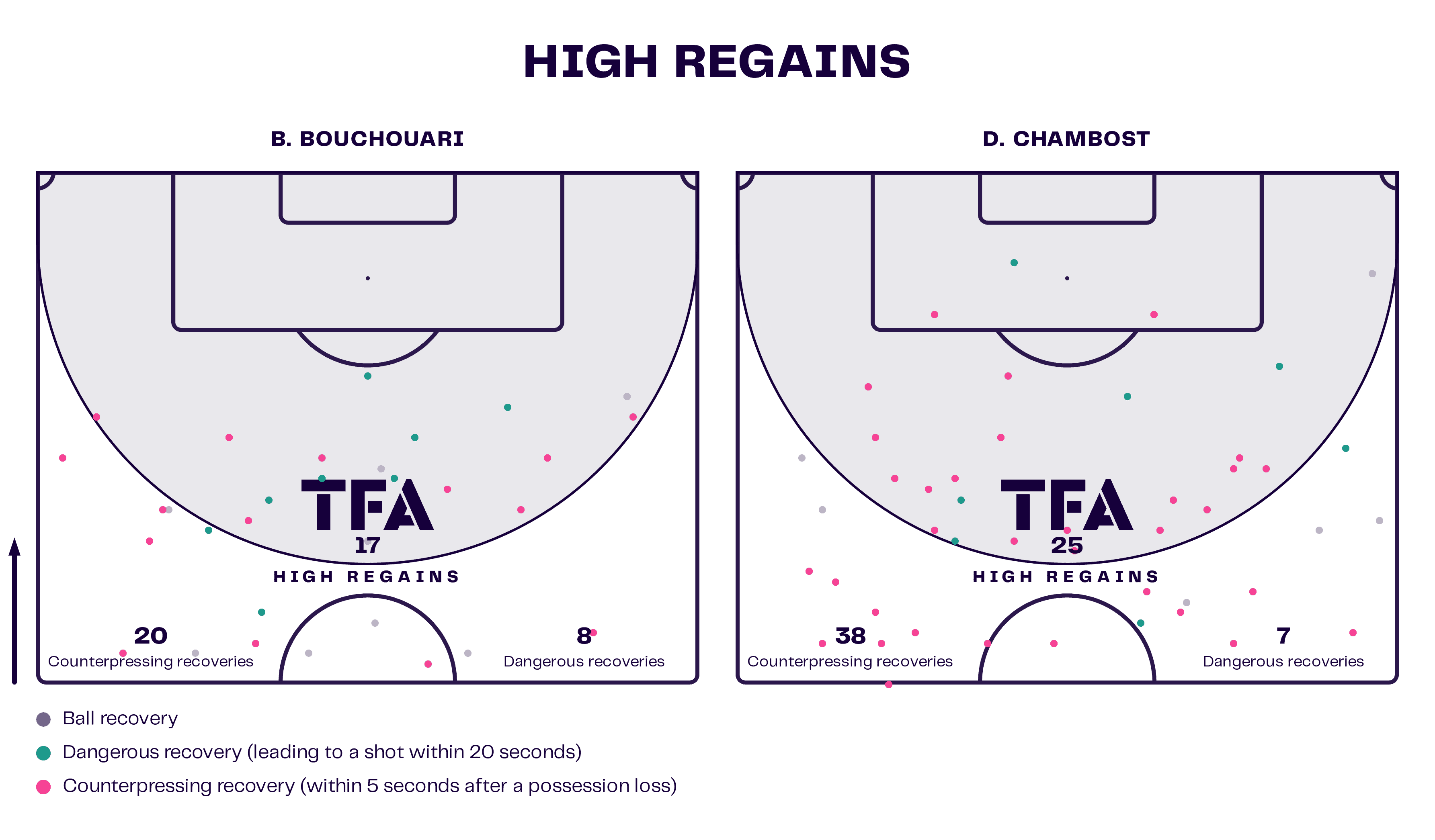
Crucially, Chambost has also made more high regains — and a lot more counterpressing recoveries — under Dall’Oglio than Bouchouari made under Batlles earlier this term, perhaps somewhat justifying Dall’Oglio’s reasoning for choosing 26-year-old Chambost over his 22-year-old teammate.
Saint-Étienne have been a lot more solid in defensive transitions under Dall’Oglio than they were under Batlles, conceding a lot fewer chances in this phase of play of late. This is partly a result of better defensive organisation but Chambost and his more significant role can’t be ignored with regard to that huge improvement either.
On top of an admirable out-of-possession work-rate, the 26-year-old midfielder demonstrates intelligent defensive positioning and a solid ability to read the game, resulting in the high number of counterpressing recoveries and stronger transition defence for Saint-Étienne.
Saint-Étienne’s improved cross defence under Olivier Dall’Oglio
For our final section of analysis, we’re going to look at how Les Verts have improved in their own box, specifically when it comes to defending against crosses, thus far under Olivier Dall’Oglio compared with his predecessor Laurent Batlles.
Batlles and his backroom staff would undoubtedly have been aware of their issue with defending crosses, but they struggled to rectify the problem sufficiently during their time in the ASSE dugout. Plenty of the goals Saint-Étienne conceded in the early part of the season came as a result of poor marking for crosses, which allowed attackers to get space and freedom to take a dangerous shot inside the box.
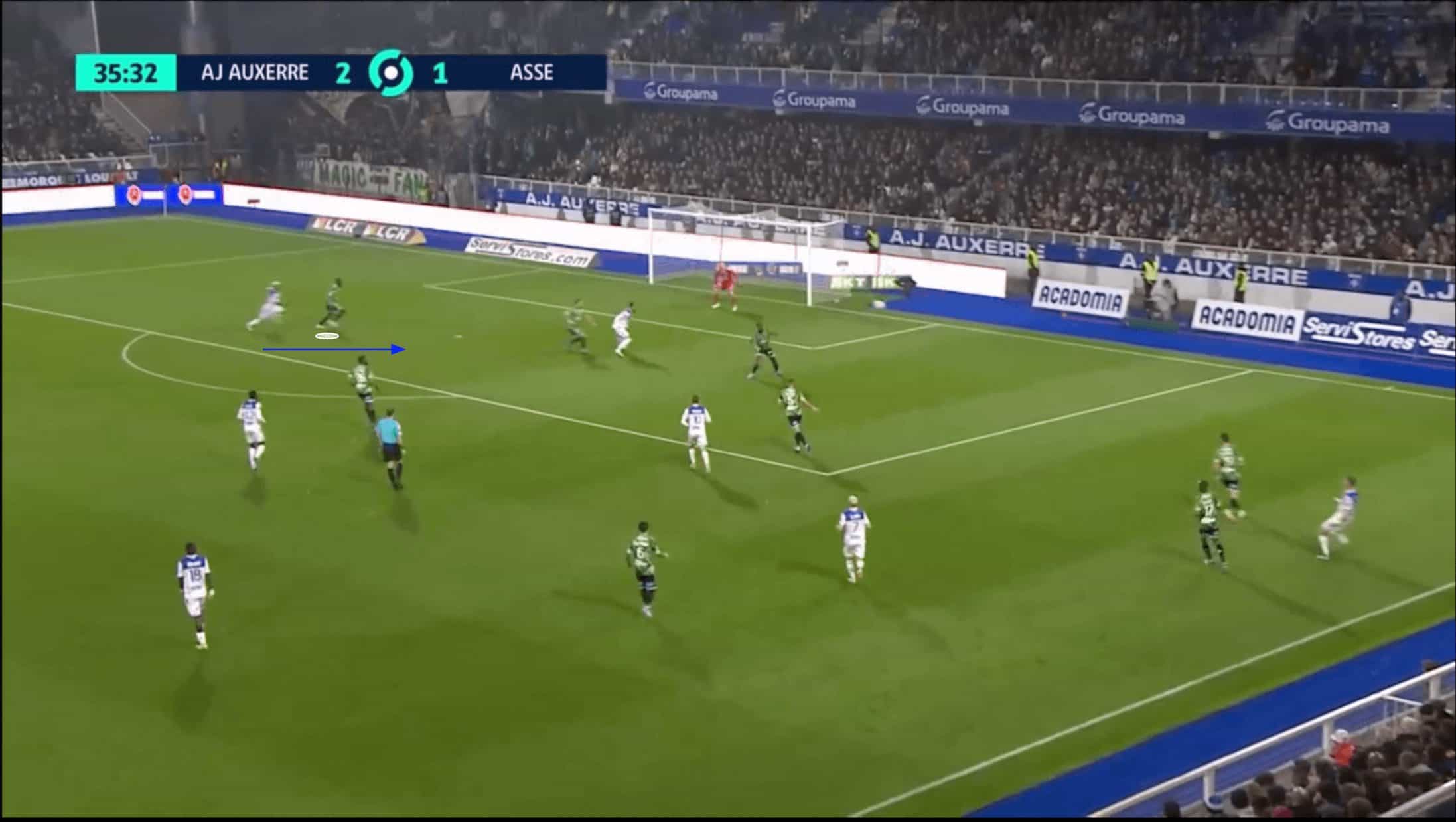
One such goal conceded came against ASSE’s promotion rivals Auxerre back in November — a game that saw Batlles’ side ship five goals in total.
Three of Auxerre’s five were scored by Ado Onaiwu, the left-winger who got in front of ASSE right-back Dennis Appiah, who failed to adequately defend Paul Joly’s cross here. Appiah’s body shape doesn’t give him a good view of Onaiwu, and it also leaves him vulnerable to the Auxerre attacker’s run across his body.
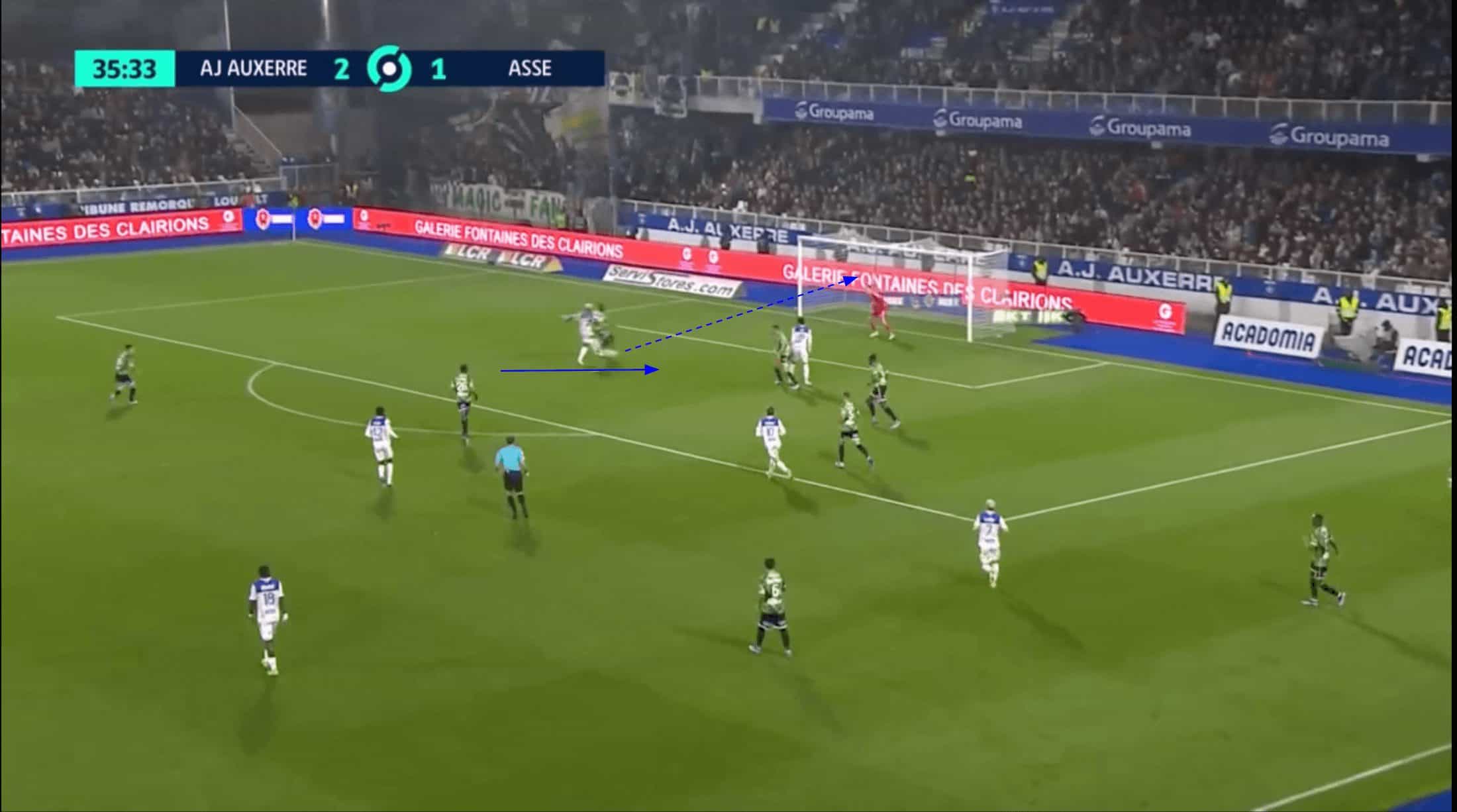
As we move on into figure 8, we see Onaiwu connecting with Joly’s cross and converting, having got in front of Appiah well.
There are numerous examples of Saint-Étienne defenders positioning their bodies poorly, losing their men or just not picking up runners as they enter the box, allowing them to enjoy way too much space throughout the first half of the 2023/24 campaign, which prove how big of an issue this was for Les Verts under Batlles.
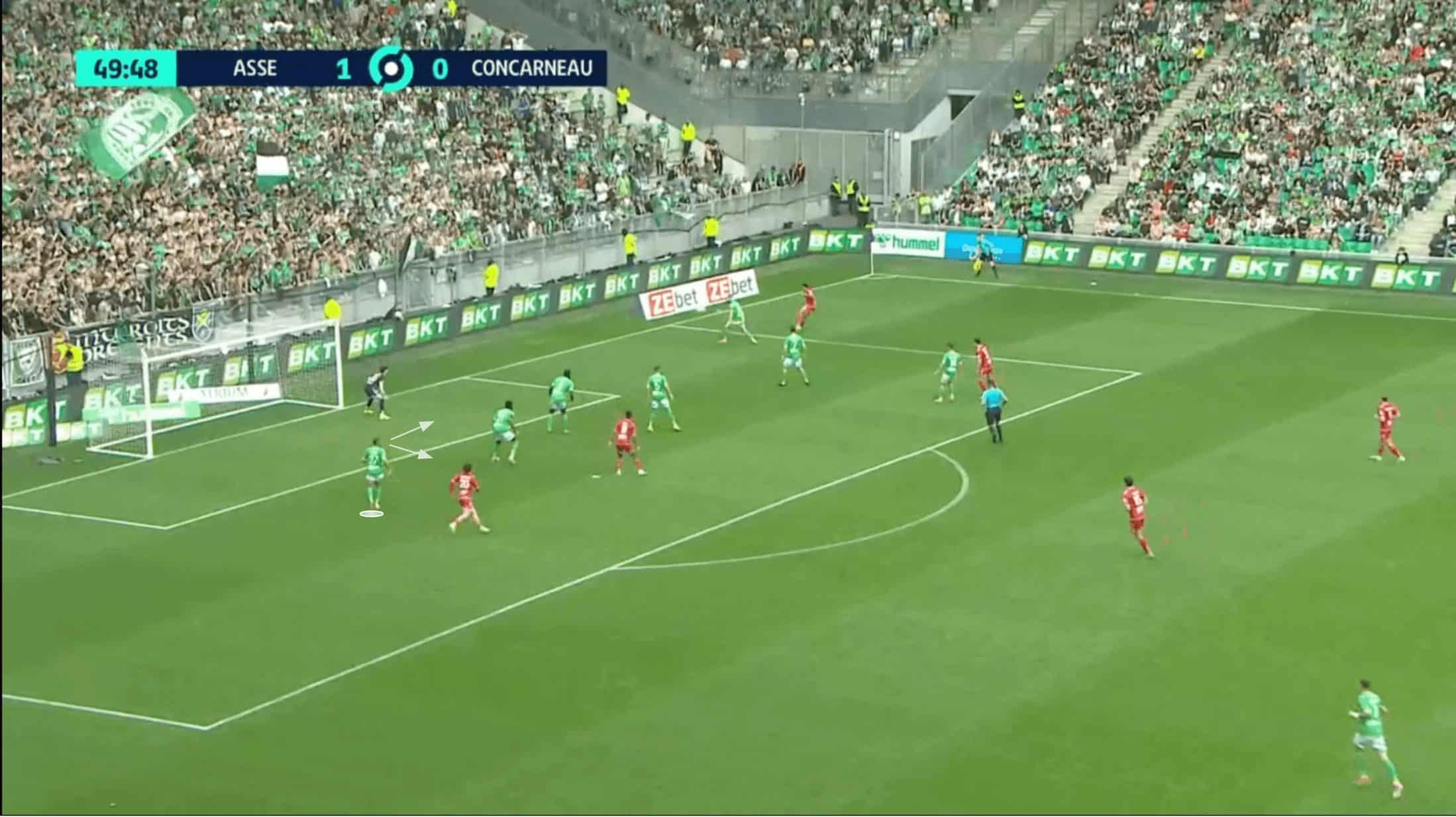
Under Dall’Oglio, they’ve fared much better in this area, and part of the credit for that, in addition to the manager’s coaching, is the return of Yvann Maçon from his spell out on loan at Maccabi Tel Aviv, where he spent the first half of the season.
Naturally a right-back, he’s primarily played at left-back under Dall’Oglio thus far but did feature on the right versus Concarneau to defend this cross in figures 9 and 10.
Firstly, in figure 9 above, we see his body positioning is much better than Appiah’s was in figures 7 and 8, allowing him a better view both of the crosser and the runner.
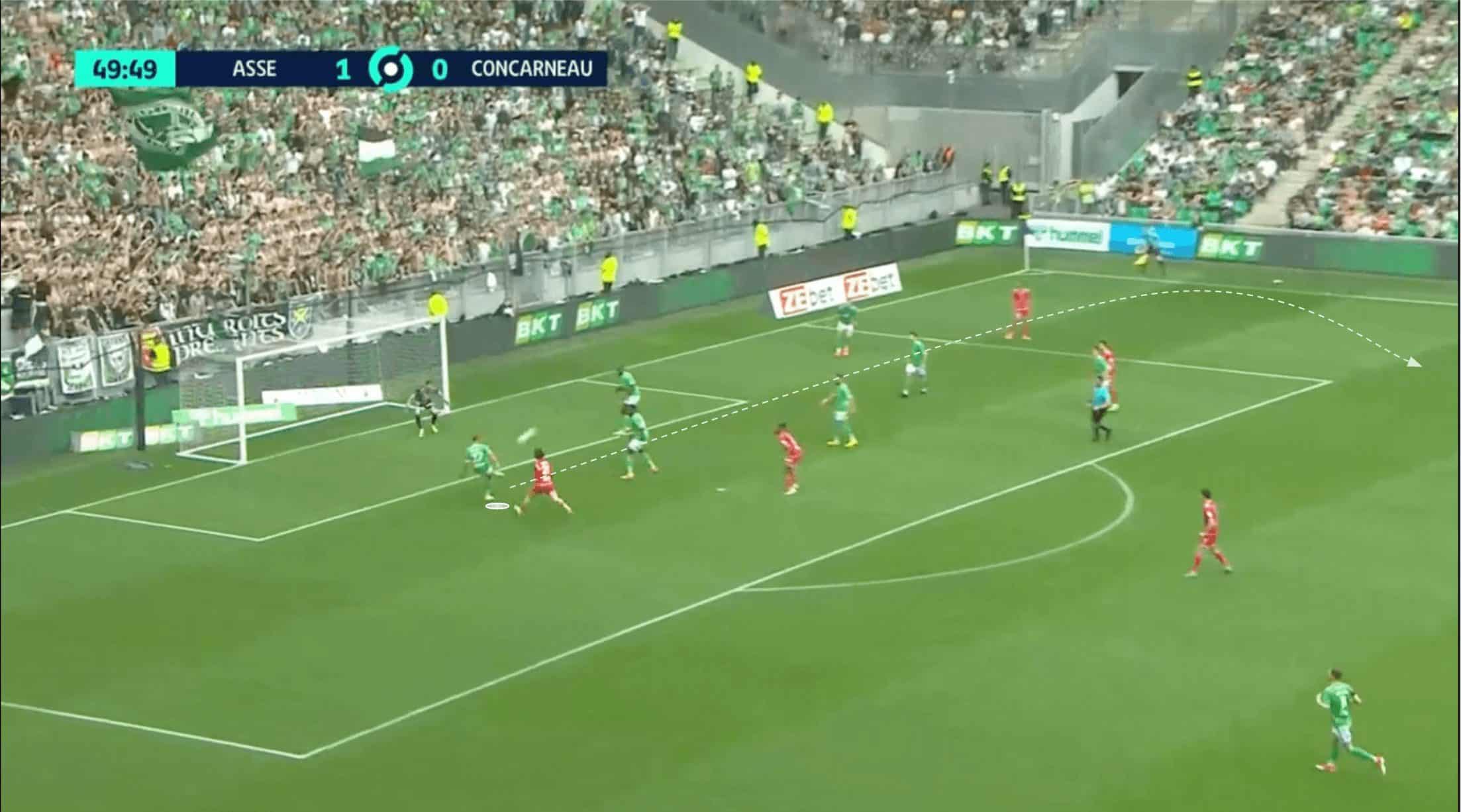
As the ball comes into the box, Maçon is positioned well to deal with it; in the end, he meets the cross and directs it out of the box. This is nothing groundbreaking, it’s just an example of the solid basics that ASSE were lacking in terms of their cross defence in the first half of the season — an area in which they’ve improved significantly under Olivier Dall’Oglio.
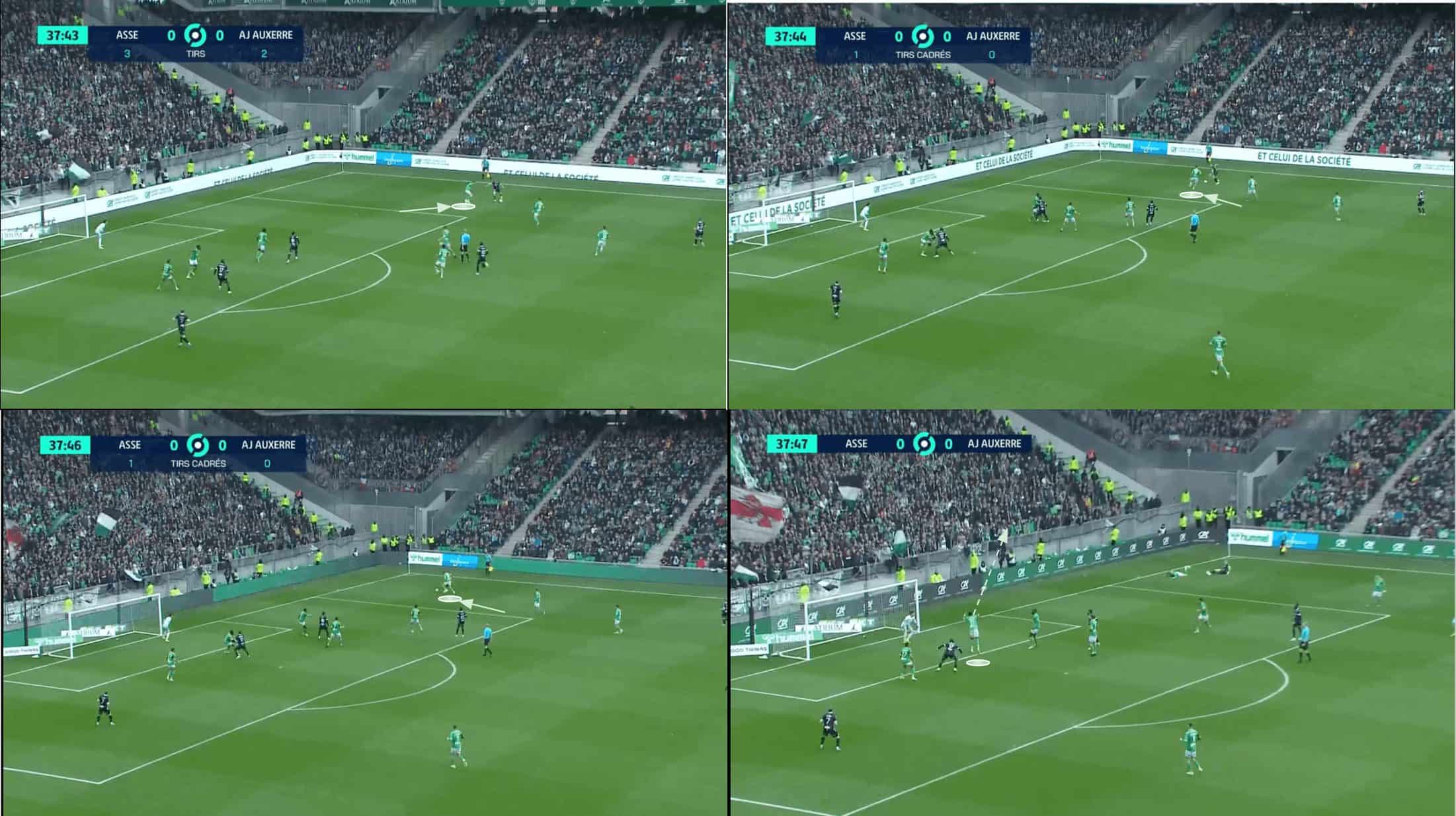
In their latest meeting with Auxerre, Saint-Étienne fared much better than they did back in November, coming away with a 1-0 win. It’s obviously impressive that they went from conceding five in November to a clean sheet in March — a nice achievement for the team based on their vast improvement between the two fixtures.
ASSE dealt with Auxerre’s wide threat in Paul Joly much better in March and demonstrated far better box-defence, as figure 11 displays.
Maçon was crucial once more in this game. At left-back here, he closed the distance to Auxerre’s right-back and stood him up excellently throughout the game. Above, we see him forcing Joly onto his weaker foot before turning well in reaction to Joly’s agile dribbling, denying him a good crossing angle on his right at first before pressuring the full-back into a rushed ball, which Saint-Étienne’s centre-back is well-positioned to clear.
Les Verts put on a far more impressive defensive display against Ligue 2’s top scorers in their most recent clash and earned their clean sheet—a clear mark of their defensive progress under Olivier Dall’Oglio. Their full-backs’ ability to close down the crossing threats and defend well 1v1 was vital to their success, as was their tighter marking, better positioning, and greater concentration inside their penalty area.
All of this has helped them significantly reduce their shots against and, crucially, goals conceded in recent months, putting them in the position we find them today as genuine promotion contenders.
Conclusion
To conclude our tactical analysis, Dall’Oglio hasn’t exactly reinvented the wheel. Still, he has got Saint-Étienne looking like a typical Dall’Oglio side without the ball, which is a hard-working, disciplined defensive unit capable of drawing the opponent into mistakes via their mid-block defence.
Furthermore, we’ve seen silly mistakes in ASSE’s box defence, which plagued their opening half of the 2023/24 campaign, become far less frequent of late, a credit to the team and their work under the new manager.
This has put an iconic team that will feel they rightly belong in Ligue 1 right back in the mix to earn their place among France’s elite for next term, setting up an intriguing Ligue 2 run-in!





Comments